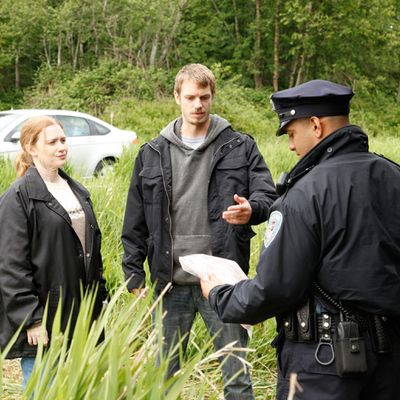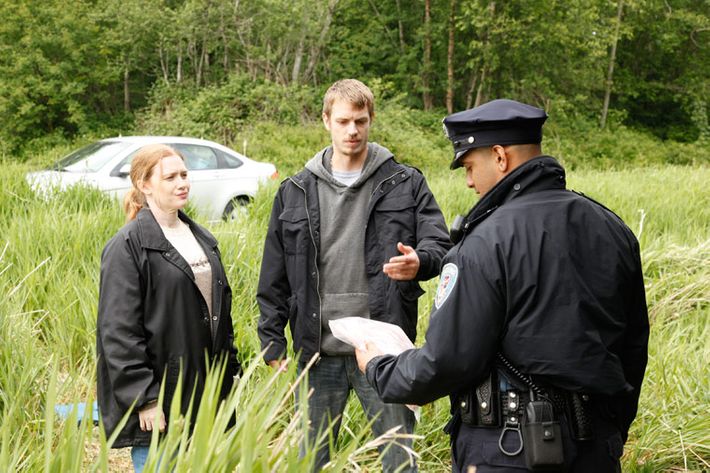

Last night’s episode of The Killing marked the show’s halfway point in the season with fingers pointing at the wife of the former teacher of the murdered Rosie Larsen. With the emergence of yet another seemingly open-and-shut-case suspect, some viewers (and Vulture’s recapper) who embraced the show early as a uniquely moody and distinctive cop show are starting to question whether The Killing is the revelatory new show that they’d hoped it would be. As the case progresses and familiar tropes emerge, is it revealing itself to be just a rainier, longer version of a CSI episode? But wait, that’s not fair: The performances are so strong! The pace so much more languid and intense! Round and round these loyal viewers go, dashing from passion to skepticism and back, and this is the argument that goes through their heads.
I’m liking The Killing. It’s so much more dense than a regular procedural, and so much bleaker than usual network fare.
Yeah, too bleak. A full third of the show is just grief porn.
Granted. But that’s what makes it so different, complicated, and human. Watching Mitch and Stan mourn their teenage daughter is excruciating, and The Killing’s signature slowness (plus top-notch performances from Michelle Forbes and Brent Sexton) makes it that much more intense. It’s super, super depressing, but it’s also an impressive display of storytelling.
Is it that impressive? By extending a procedural onto a bigger canvas, it means more sides to the story, but that doesn’t mean all these sides are riveting. One is people weeping, and another is the mayoral race, which I still don’t care about. By the rule of Narrowed It Down to the Guy I Recognize, either Billy Campbell or Alan Dale is deeply involved in Rosie’s murder. But Campbell’s character isn’t even interesting. Who cares if he wins?
Maybe the mayoral race is playing two different roles for the series: First, its literal plot, which is connected — somehow! — to Rosie’s death. But second, it’s more of a stand-in for everyone who gets derailed when a tragedy like this happens: You don’t have to be deeply, intimately connected to someone for their death to have a major effect on you. It’s part of the contrast: Grief is incredibly isolating, but loss metastasizes incredibly quickly. Rosie’s parents feel completely, devastatingly alone in their misery, and yet their daughter’s death is echoing through their whole city.
Okay … maybe. But that brings us to the last side of the show: the police work, which is the most important and maybe most problematic part. Linden and Holder are the most engaging characters, but the investigation is just a drawn-out episode of Law & Order. Exhibit A: They’re cops! With very different personalities! Who maybe take cases a liiiiiiittle too personally sometimes. Exhibit B: The parade of stereotypical junkies, skate punks, neighbors, witnesses. Exhibit C: The obvious suspects who turn out to be red herrings — but here, instead of them being ruled out in ten minutes, they’re ruled out over two episodes. It’s all pretty well-worn territory.
Well … is that inherently a bad thing? L&O and its progeny use the procedural format because it works. The investigation should kick off with some dead ends, and there will be suspects that the police eventually eliminate. Some tropes are inevitable, it’s just a matter of how they use them.
But a trope is a trope. The point of a season-long procedural is to make us wonder who the killer is, but every time we see a well-worn trope, it automatically demystifies things and reminds us of the rules of a familiar format. For example, it’s only halfway through the season, so we know Bennett can’t be the real killer. Unless he is the real killer (or is in on it with his wife), in which case, what a hot-for-teacher cliché. Booo.
Or maybe it’s a brilliant twist on a mystery format we’ve been so conditioned to. Instead of spending the second half of the season solving a murder, now the show’s solving two things: Rosie’s murder and Bennett’s abduction. What a mindfuck!
Come on, that’s not going to happen.
It might! It could be like 24, which would introduce new enemies mid-season and send Jack in a completely different direction.
But this show was billed as a thirteen-episode whodunnit. Turning it into a seven-day chase for a recidivist mob enforcer would be a betrayal of the show’s promise.
Still, I’m not convinced that it’s as simple as Bennett’s wife killing her and him helping her dispose of the body. I think that’s not giving the show enough credit.
How has it earned the credit? Name a procedural rule that it’s broken. Another one it hasn’t: We barely know our main characters. We’re only getting minor slivers of their backgrounds week to week.
But we’re getting surprisingly vivid secondary characters. There’s the Worst Principal Ever. There’s Rosie’s aunt, who definitely knows something we haven’t learned yet; there’s Denny and Tom, whose grief is greater than their ability to comprehend it. Did the show need barf-o-vision last week for Jamie? No, but it demonstrated The Killing’s commitment to the smaller characters, to give everyone some kind of story line. That’s not a CSI thing or a Law & Order thing — it’s a Twin Peaks or a Veronica Mars thing. Pretty heartening company.
Can the show at least drop the pretense that Linden is going to go to California before this case is solved?
Actually, yeah, can it? That part just seems silly at this point.




